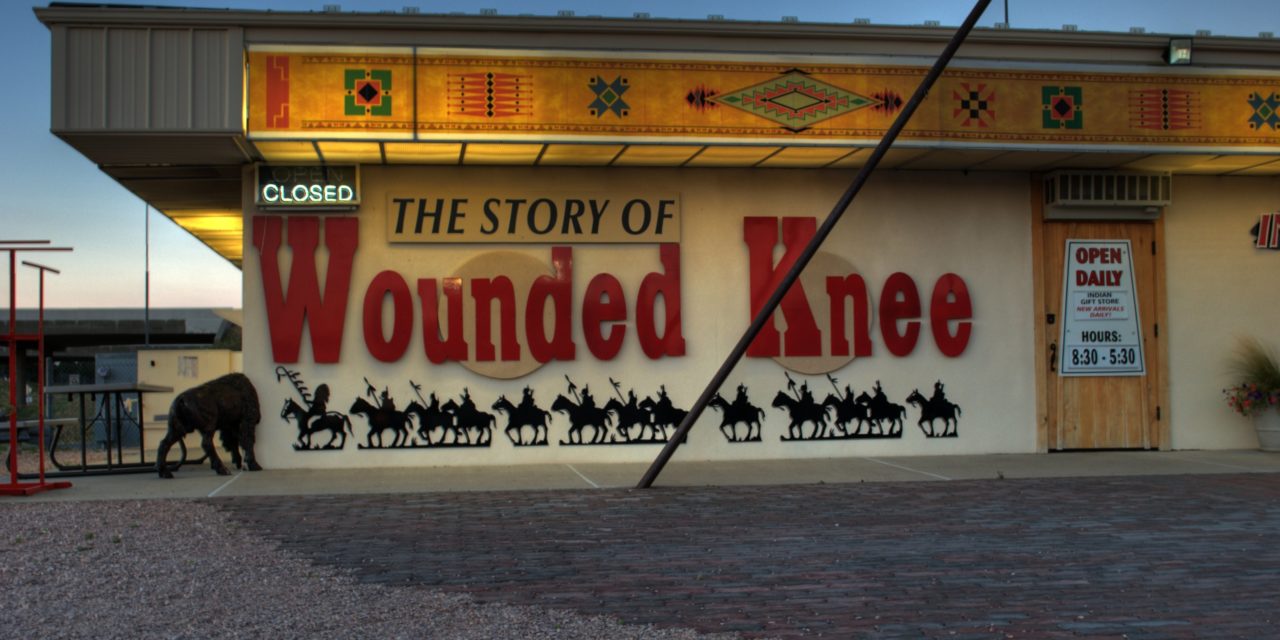After Wounded Knee
Adam Spry
In The Heartbeat of Wounded Knee, David Treuer has set himself an almost impossible task. To capture the whole scope of Native American history since 1890 is ambitious, to say the least. Not only did this period see massive shifts in federal Indian policy (ranging from outright genocidal violence to mind-numbing bureaucratic gridlock), but those shifts were experienced by hundreds of different tribal nations who weathered them in a variety of ways. For someone familiar with the topic, the idea of recounting this complex history in a scant 450 pages would inevitably mean redeploying a set of all-too-familiar platitudes: inadequate reservations, endemic poverty, governmental failure. Wash, rinse, repeat.
And while there are platitudes to be found in The Heartbeat of Wounded Knee, Treuer succeeds more often than he fails in offering a compelling and nuanced treatment of Native life after 1890—doing a far better job than many, if not most, of the available popular works on this period.
Treuer’s decision to take on such a challenge seems driven by a desperate need to correct the record. For almost half a century, Dee Brown’s Bury My Heart at Wounded Knee (1970) has been treated by many as the definitive history of American Indians, despite the fact that it really only covers the tumultuous decades between 1860 and 1890, when U.S. Indian policy took on its most militaristic and genocidal face. Ending with the massacre of as many as three hundred Lakota by the Seventh Calvary in 1890, Brown’s book (aided by its evocative title) presents Wounded Knee as a kind of event horizon for Native history—a tragic climax so decisive that all that came after it could only be treated as denouement.
But Treuer does not simply pick up where Brown left off. Instead, he works to reframe how we think about Native history from its very beginnings. The Heartbeat of Wounded Knee starts with a whirlwind tour through pre-colonial North America, offering a snapshot of tribal life across the continent. Treuer takes pains to show that many, if not most, Native societies (whose populations numbered in the millions) were in fact much like those in Europe: constructing large urban centers, participating in transcontinental trade networks, and practicing extensive agriculture. Though it distracts from the book’s mission of covering post-1890 U.S history, Treuer’s decision to cover this material is unfortunately necessary—not only to inform a readership likely unfamiliar with it, but also to show the devastating effect of colonization on the continent and its peoples.
Treuer shows that the image of nomadic, primitive Indian that lay at the heart of the U.S.’s assimilation policies (and Brown’s own book) is actually the image of a people rent from their homelands and histories, murdered and raped with impunity, and ultimately saddled with the burden of racial difference in a white supremacist society. By the time we get to the eponymous events at Wounded Knee, we see it less as Dee Brown does—a last blow to a sense of Native dignity and freedom—and more as the senseless and brutal slaughter of weary refugees trying to escape four centuries of devastation.
Once we get past 1890 (almost one hundred pages in), The Heartbeat of Wounded Knee shifts gears, both in content and theme, to examine the events of the past century as a period in which Native peoples “poked their heads aboveground and surveyed the desolation of their homelands and asked [. . .] What can we do next to survive?” The hopefulness of Treuer’s tone is meant to as a challenge to a history often framed by images of squalid reservations, horrific boarding schools, and endemic racism.
While not dismissing the difficult realities of the period, Treuer works to show how Native people, as both individuals and tribal nations, worked within the systems of domination created by the United States to reclaim a degree of self-determination and agency. Treuer hopes to show, as he puts it, “the ingenious and resourceful counterattacks we [Native peoples] have mounted over the decades, in resistance to the life the state would have us live.” Native youth in boarding schools suffered disease, malnourishment, and constant assimilative pressure, but also created the foundation for a united, intertribal resistance, led by those educated in the very institutions they fought to dismantle. The opening of reservations to non-Native settlement (resulting in the loss of millions of acres of what little remained of Indian land) devastated many tribal polities, but galvanized others, such as the Red Lake Ojibwe, into reasserting their sovereignty in stronger ways.
Some might dismiss such narratives as rationalizing, or even embracing, the U.S.’s assimilatory goals. Yet Treuer’s approach to this history is, to my mind, a necessary one. More often than not, even sympathetic writers (perhaps especially sympathetic writers) present Indigenous people as history’s ultimate victims, unable to experience anything more than loss, lest they implicate Natives in their own destruction. But Treuer, quoting Marx, reminds us that “Men make their own history, but they do not make it as they please; they do not make it under self-selected circumstances, but under circumstances existing already, given and transmitted from the past.” To withhold this sense of historical agency from Native people, the ability to adapt and attempt to overcome the horrors of U.S. colonialism in ways both inspiring and contradictory, is to replicate Dee Brown’s treatment of the victims of Wounded Knee, who, as Treuer puts it, “died twice—once at the end of a gun, and again at the end of a pen.”
However, in offering its corrective to Dee Brown’s work, The Heartbeat of Wounded Knee unfortunately replicates some of its most frustrating features. With an emphasis on reportage, the book attempts to distill the effects of shifting federal Indian policies in the stories of individual Natives who experienced them. Interviewing a Blackfeet rodeo rider, for example, who was moved from a reservation in rural Montana to the turmoil of 1968 Compton, Treuer is able to illustrate the cultural and economic disruption wrought by the U.S.’s midcentury effort to assimilate Natives through urban relocation. Or, in reflecting on his own grandfather’s suicide, Treuer examines the effects of military service on Native people, who join the armed forces at rates far higher than any other group in the U.S.—despite the military’s violent subjugation of their recent ancestors. Like Brown’s history, this focus on the intimate and particular gives a degree of emotional weight to what would be for many an otherwise obscure set of policy initiatives, but it also tends to draw attention away from the political processes by which these policies were enforced or resisted, and therefore from a more synthetic understanding of the U.S.’s century-long dialectical swing between eradicating tribal polities and empowering them.
Such a shortcoming may only be the gripe of a scholar with a professional interest in theorization, however, and should not be seen as reason to consign Treuer’s book to the same corner as Ian Frazier’s reductive On The Rez, Naomi Riley’s naked free-marketeering in The New Trail of Tears, or any number of sensationalist depictions of the Pine Ridge Reservation in newspapers or on television. No, Treuer’s work is important, and should be read, if for no other reason than its continual insistence on the ambiguities of Native life in the years since Wounded Knee.
Indeed, the most successful and illuminating parts of The Heartbeat of Wounded Knee come near its end, where Treuer examines the ways in which many Tribal nations have become minor economic powers through gaming operations, resource extraction, and land development since the introduction of Richard Nixon’s ‘Self-Determination’ policy in 1970. Treuer’s even-handed account of Indian Country’s embrace of enterprise may come as the most shocking twist in a book dedicated to upturning expectations—and a potent reminder what it means to survive in an age of capitalist hegemony. As a modern-day Ojibwe hunter-gatherer interviewed by Treuer memorably puts it: “I look over […] creation and sometimes I don’t see it like other people do. I look out at all of it and what I see is money. And by God I’m going to find a way to liberate it out of there.” So fares the earth-loving Indian in the age of global free trade.
Full of neither saccharine hope nor fretful hand-wringing, The Heartbeat of Wounded Knee is a compelling, if uneven, account of Native survival at all costs—good, bad, and indifferent. That its mixture of interviews, documentary history, and anecdote hangs together at all is not only a testament to Treuer’s abilities, but a fitting parallel to the theme that threads its way throughout the book: to look at the fragmented mess colonization has made of their lives and communities and still see Native people a coherent whole, still recognizable even after five centuries of disaster.


